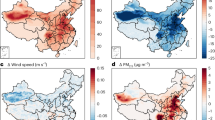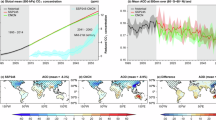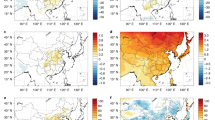Abstract
Severe air pollution reduces ecosystem carbon assimilation through the vegetation damaging effects of ozone and by altering the climate through aerosol effects, exacerbating global warming. In response, China implemented the Clean Air Action plan in 2013 to reduce anthropogenic emissions. Here we assess the impact of air pollution reductions due to the Clean Air Action plan on net primary productivity (NPP) in China during the period 2014–2020 using multiple measurements, process-based models and machine learning algorithms. The Clean Air Action plan led to a national NPP increase of 26.3 ± 27.9 TgC yr−1, of which 20.1 ± 10.9 TgC yr−1 is attributed to aerosol reductions, driven by both the enhanced light availability as a result of decreased black carbon concentrations and the increased precipitation caused by weakened aerosol climatic effects. The impact of ozone amelioration became more important over time, surpassing the effects of aerosol reduction by 2020, and is expected to drive future NPP recovery. Two machine learning models simulated similar NPP recoveries of 42.8 ± 26.8 TgC yr−1 and 43.4 ± 30.1 TgC yr−1. Our study highlights substantial carbon gains from controlling aerosols and surface ozone, underscoring the co-benefits of regulating air pollution for public health and carbon neutrality in China.
This is a preview of subscription content, access via your institution
Access options
Access Nature and 54 other Nature Portfolio journals
Get Nature+, our best-value online-access subscription
27,99 € / 30 days
cancel any time
Subscribe to this journal
Receive 12 print issues and online access
269,00 € per year
only 22,42 € per issue
Buy this article
- Purchase on SpringerLink
- Instant access to full article PDF
Prices may be subject to local taxes which are calculated during checkout





Similar content being viewed by others
Data availability
All simulations that support the finding of this study and source data underlying Figs. 1–5 are publicly available via Figshare at https://doi.org/10.6084/m9.figshare.27186126.v1 (ref. 62). The data used in this study are available publicly from the following databases. GLASS 8-day 500 m NPP and leaf area index data were obtained from the University of Maryland at http://www.glass.umd.edu/. The land-cover data in China are available via the National Ecosystem Research Network Data Center at https://doi.org/10.12199/nesdc.ecodb.rs.2023.015 (ref. 63). Gridded PM2.5 and MDA8 O3 data were downloaded from Tsinghua University at http://tapdata.org.cn. The meteorological datasets are from the ERA-5 reanalysis (https://www.ecmwf.int/) and monthly spatial CO2 data are available in ref. 44.
Code availability
The codes for the processed-based and data-driven models are publicly available from the following sources. The codes for iMAPLE are available via Figshare at https://doi.org/10.6084/m9.figshare.23593578.v1 (ref. 64) and CRM is openly available at https://www.ess.uci.edu/~zender/. GEOS-Chem is developed and updated by the Atmospheric Chemistry Modeling Group at Harvard University and is available at https://acmg.seas.harvard.edu/geos/. The Python codes for XGB and RF used in the data-driven models are available at https://xgboost.readthedocs.io/en/latest/python/ and https://scikit-learn.org/stable/modules/ensemble.html, respectively.
References
Sheehan, P., Cheng, E., English, A. & Sun, F. China’s response to the air pollution shock. Nat. Clim. Change 4, 306–309 (2014).
Zheng, B. et al. Trends in China’s anthropogenic emissions since 2010 as the consequence of clean air actions. Atmos. Chem. Phys. 18, 14095–14111 (2018).
Xue, T. et al. Rapid improvement of PM2.5 pollution and associated health benefits in China during 2013–2017. Sci. China Earth Sci. 62, 1847–1856 (2019).
Zhang, Q. et al. Drivers of improved PM2.5 air quality in China from 2013 to 2017. Proc. Natl Acad. Sci. USA 116, 24463–24469 (2019).
Li, K., Jacob, D. J., Shen, L., Lu, X., De Smedt, I. & Liao, H. Increases in surface ozone pollution in China from 2013 to 2019: anthropogenic and meteorological influences. Atmos. Chem. Phys. 20, 11423–11433 (2020).
Liu, H. et al. Ground-level ozone pollution and its health impacts in China. Atmos. Environ. 173, 223–230 (2018).
Lu, X. et al. Progress of air pollution control in China and its challenges and opportunities in the ecological civilization era. Engineering 6, 1423–1431 (2020).
Zhou, H. et al. Distinguishing the impacts of natural and anthropogenic aerosols on global gross primary productivity through diffuse fertilization effect. Atmos. Chem. Phys. 22, 693–709 (2022).
Unger, N., Zheng, Y., Yue, X. & Harper, K. L. Mitigation of ozone damage to the world’s land ecosystems by source sector. Nat. Clim. Change 10, 134–137 (2020).
Mercado, L. M. et al. Impact of changes in diffuse radiation on the global land carbon sink. Nature 458, 1014–U1087 (2009).
Zhou, H. et al. Aerosol radiative and climatic effects on ecosystem productivity and evapotranspiration. Curr. Opin. Environ. Sci. Health 19, 100218 (2021).
Zhang, Y. et al. Increased global land carbon sink due to aerosol-induced cooling. Glob. Biogeochem. Cycles 33, 439–457 (2019).
Malavelle, F. F. et al. Studying the impact of biomass burning aerosol radiative and climate effects on the Amazon rainforest productivity with an Earth system model. Atmos. Chem. Phys. 19, 1301–1326 (2019).
Keppel-Aleks, G. & Washenfelder, R. A. The effect of atmospheric sulfate reductions on diffuse radiation and photosynthesis in the United States during 1995-2013. Geophys. Res. Lett. 43, 9984–9993 (2016).
Jing, X. et al. The effects of clouds and aerosols on net ecosystem CO2 exchange over semi-arid Loess Plateau of northwest China. Atmos. Chem. Phys. 10, 8205–8218 (2010).
Yue, X. & Unger, N. Fire air pollution reduces global terrestrial productivity. Nat. Commun. 9, 5413 (2018).
Cohan, D. S., Xu, J., Greenwald, R., Bergin, M. H. & Chameides, W. L. Impact of atmospheric aerosol light scattering and absorption on terrestrial net primary productivity. Glob. Biogeochem. Cycles 16, 1090 (2002).
Yue, X. et al. Ozone and haze pollution weakens net primary productivity in China. Atmos. Chem. Phys. 17, 6073–6089 (2017).
Wittig, V. E., Ainsworth, E. A. & Long, S. P. To what extent do current and projected increases in surface ozone affect photosynthesis and stomatal conductance of trees? A meta-analytic review of the last 3 decades of experiments. Plant Cell Environ. 30, 1150–1162 (2007).
Piao, S. et al. The carbon balance of terrestrial ecosystems in China. Nature 458, 1009–1013 (2009).
Wang, J. et al. Large Chinese land carbon sink estimated from atmospheric carbon dioxide data. Nature 586, 720–723 (2020).
Yue, X. et al. Development and evaluation of the interactive Model for Air Pollution and Land Ecosystems (iMAPLE) version 1.0. Geosci Model Dev. 17, 4621–4642 (2024).
Sitch, S., Cox, P. M., Collins, W. J. & Huntingford, C. Indirect radiative forcing of climate change through ozone effects on the land-carbon sink. Nature 448, 791–794 (2007).
Spitters, C. J. T., Toussaint, H. & Goudriaan, J. Separating the diffuse and direct component of global radiation and its implications for modeling canopy photosynthesis. Part 1. Components of incoming radiation. Agric. For. Meteorol. 38, 217–229 (1986).
Yue, X. & Unger, N. Aerosol optical depth thresholds as a tool to assess diffuse radiation fertilization of the land carbon uptake in China. Atmos. Chem. Phys. 17, 1329–1342 (2017).
Krishnamohan, K. S., Bala, G., Cao, L., Duan, L. & Caldeira, K. The climatic effects of hygroscopic growth of sulfate aerosols in the stratosphere. Earth Future 8, e2019EF001326 (2020).
Li, K. et al. A two-pollutant strategy for improving ozone and particulate air quality in China. Nat. Geosci. 12, 906–910 (2019).
Li, K. et al. Ozone pollution in the North China Plain spreading into the late-winter haze season. Proc. Natl Acad. Sci. USA 118, e2015797118 (2021).
Yue, X. et al. Large potential of strengthening the land carbon sink in China through anthropogenic interventions. Sci. Bull. 69, 2622–2631 (2024).
Yu, Z. et al. Forest expansion dominates China’s land carbon sink since 1980. Nat. Commun. 13, 5374 (2022).
Duan, J. et al. Absorbable aerosols based on OMI data: a case study in three provinces of Northeast China. Environ. Monit. Assess. 193, 479 (2021).
Geng, G. et al. Tracking air pollution in China: near real-time PM2.5 retrievals from multisource data fusion. Environ. Sci. Technol. 55, 12106–12115 (2021).
Zhou, H. et al. Responses of gross primary productivity to diffuse radiation at global FLUXNET sites. Atmos. Environ. 244, 117905 (2021).
Hong, S. et al. Divergent responses of soil organic carbon to afforestation. Nat. Sustain. 3, 694–700 (2020).
Shi, S. & Han, P. Estimating the soil carbon sequestration potential of China’s Grain for Green Project. Glob. Biogeochem. Cycles 28, 1279–1294 (2014).
Xia, J. et al. Reconstructing long-term forest age of China by combining forest inventories, satellite-based forest age and forest cover data sets. J. Geophys. Res. Biogeosci. 128, e2023JG007492 (2023).
Han, P. et al. Evaluating China’s fossil-fuel CO2 emissions from a comprehensive dataset of nine inventories. Atmos. Chem. Phys. 20, 11371–11385 (2020).
Xinliang, X. China’s Multi-Year Provincial Administrative Division Boundary Data (Resource and Environment Science and Data Center, Institute of Geographic Sciences and Natural Resources Research, Chinese Academy of Sciences, 2023); https://doi.org/10.12078/2023010103
Zhang, W. et al. State-of-the-art review of soft computing applications in underground excavations. Geosci. Front. 11, 1095–1106 (2020).
Chen, J. et al. A comparison of linear regression, regularization, and machine learning algorithms to develop Europe-wide spatial models of fine particles and nitrogen dioxide. Environ. Int. 130, 104934 (2019).
Zhou, H. et al. Distinguishing the main climatic drivers to the variability of gross primary productivity at global FLUXNET sites. Environ. Res. Lett. 18, 124007 (2023).
Park, S. et al. Robust spatiotemporal estimation of PM concentrations using boosting-based ensemble models. Sustainability 13, 13782 (2021).
Wang, H. et al. Exploring complex water stress–gross primary production relationships: impact of climatic drivers, main effects, and interactive effects. Glob. Change Biol. 28, 4110–4123 (2022).
Liu, Z. et al. Improving the joint estimation of CO2 and surface carbon fluxes using a constrained ensemble Kalman filter in COLA (v1.0). Geosci. Model Dev. 15, 5511–5528 (2022).
Muñoz-Sabater, J. et al. ERA5-Land: a state-of-the-art global reanalysis dataset for land applications. Earth Syst. Sci. Data 13, 4349–4383 (2021).
Liang, S. et al. A long-term Global LAnd Surface Satellite (GLASS) data-set for environmental studies. Int. J. Digit. Earth 6, 5–33 (2013).
Liang, S. et al. The Global Land Surface Satellite (GLASS) product suite. Bull. Am. Meteorol. Soc. 102, E323–E337 (2021).
Bey, I. et al. Global modeling of tropospheric chemistry with assimilated meteorology: model description and evaluation. J. Geophys. Res. Atmos. 106, 23073–23095 (2001).
Gelaro, R. et al. The Modern-Era Retrospective analysis for Research and Applications, version 2 (MERRA-2). J. Clim. 30, 5419–5454 (2017).
Yue, X. & Liao, H. Climatic responses to the shortwave and longwave direct radiative effects of sea salt aerosol in present day and the last glacial maximum. Clim. Dynam. 39, 3019–3040 (2012).
Yue, X., Wang, H. J., Liao, H. & Fan, K. Simulation of dust aerosol radiative feedback using the GMOD: 2. Dust-climate interactions. J. Geophys. Res. Atmos. 115, 843–858 (2010).
Giorgi, F. et al. RegCM4: model description and preliminary tests over multiple CORDEX domains. Clim. Res. 52, 7–29 (2012).
Gao, J. et al. Climate responses in China to domestic and foreign aerosol changes due to clean air actions during 2013–2019. npj Clim. Atmos. Sci. 6, 160 (2023).
Yue, X. & Unger, N. The Yale Interactive terrestrial Biosphere model version 1.0: description, evaluation and implementation into NASA GISS ModelE2. Geosci. Model Dev. 8, 2399–2417 (2015).
Friedlingstein, P. et al. Global carbon budget 2020. Earth Syst. Sci. Data 12, 3269–3340 (2020).
Farquhar, G. D., Caemmerer, S. V. & Berry, J. A. A biochemical-model of photosynthetic CO2 assimilation in leaves of C3 species. Planta 149, 78–90 (1980).
Ball, J. T., Woodrow, I. E. & Berry, J. A. in Progress in Photosynthesis Research Vol. 4 (ed. Biggins, J.) 221–224 (Springer, 1987).
Sun, L. et al. Impacts of meteorology and emissions on summertime surface ozone increases over central eastern China between 2003 and 2015. Atmos. Chem. Phys. 19, 1455–1469 (2019).
Li, J., Jiang, Y. W., Xia, X. G. & Hu, Y. Y. Increase of surface solar irradiance across east China related to changes in aerosol properties during the past decade. Environ. Res. Lett. 13, 034006 (2018).
Chen, L., Shi G., Wang, B. & Zhang, P. Assessment on aerosol direct radiative forcing over China land areas based on satellite data. In Proc. Remote sensing of the environment: the 17th China Conference on Remote Sensing 82031A (SPIE, 2011).
Folini, D. & Wild, M. The effect of aerosols and sea surface temperature on China’s climate in the late twentieth century from ensembles of global climate simulations. J. Geophys. Res. Atmos. 120, 2261–2279 (2015).
Zhou, H. et al. Recovery of ecosystem productivity in China by the Clean Air Action plan. figshare https://doi.org/10.6084/m9.figshare.27186126.v1 (2024).
Tian, C. Interactive Model for Air Pollution and Land Ecosystems (iMAPLE) version 1.0. figshare https://doi.org/10.6084/m9.figshare.23593578.v1 (2023).
Xia, X. et al. Land Use, Coverage and Change Dataset in China from 1980 to 2021 (National Ecological Data Center, 2023); https://doi.org/10.12199/nesdc.ecodb.rs.2023.015
Acknowledgements
This work was jointly supported by the National Natural Science Foundation of China (grant numbers 42293323 and 42275128 to X.Y.), the Natural Science Foundation of Jiangsu Province (grant number BK20220031 to X.Y.) and the National University of Defense Technology Independent Research Project (grant number ZK24-52 to H.Z.).
Author information
Authors and Affiliations
Contributions
H.Z., X.Y. and H.L. conceived this project. X.Y. led the research and was responsible for communicating with all authors about the data, methods and results. H.Z. collected observational data and performed simulations with input from H.D., G.G. and W.Y. H.Z. completed data analyses and the first draft of the paper. X.Y. and H.L. reviewed and edited the paper. J.C., G.S., T.Z. and J.Z. helped to revise the paper.
Corresponding author
Ethics declarations
Competing interests
The authors declare no competing interests.
Peer review
Peer review information
Nature Geoscience thanks Xitian Cai, William Collins and the other, anonymous, reviewer(s) for their contribution to the peer review of this work. Primary Handling Editor: Xujia Jiang, in collaboration with the Nature Geoscience team.
Additional information
Publisher’s note Springer Nature remains neutral with regard to jurisdictional claims in published maps and institutional affiliations.
Extended data
Extended Data Fig. 1 Spatial pattern of NPP changes due to baseline air pollutants.
Results shown are the changes of NPP (g C m−2 day−1) during May-September caused by (a) aerosols, (b) ozone, and (c) their combined effects during 2014-2020 from simulations with and without air pollutants. The aerosol impacts are further separated into (d) radiative and (e) climatic effects on NPP. The national total changes in NPP (Tg C yr−1) are shown on each panel. Basemaps (including inset maps) of China are adopted from the Resource and Environment Science and Data Center, ref. 38.
Extended Data Fig. 2 Responses of NPP to the radiative effects of baseline aerosol species.
Results shown are the impacts of five aerosol species including (a) black carbon, (b) organic carbon, (c) sulfate and nitrate, (d) sea salt and (e) dust on May-September NPP in China during 2014-2020 through perturbations in diffuse and direct radiation. Please notice the differences in color scales. The units are g C m−2 day−1. Basemaps (including inset maps) of China are adopted from the Resource and Environment Science and Data Center, ref. 38.
Extended Data Fig. 3 Responses of NPP to baseline aerosol climatic effects.
Results shown are the impacts of aerosol-induced changes in (a) temperature and (b) precipitation on May-September NPP (g C m−2 day−1) in China during 2014-2020. Basemaps (including inset maps) of China are adopted from the Resource and Environment Science and Data Center, ref. 38.
Extended Data Fig. 4 NPP recovery due to changes in aerosol radiative and climatic effects following CAA plans in China.
Results shown are the changes in May-September NPP (g C m−2 day−1) due to the CAA-induced changes in aerosol (a) radiative and (b) climatic effects during 2014-2020. Basemaps (including inset maps) of China are adopted from the Resource and Environment Science and Data Center, ref. 38.
Extended Data Fig. 5 NPP responses to changes in aerosol radiative and climatic effects following CAA plans in China.
Results shown are the changes in May-September NPP (g C m−2 day−1) due to the CAA-induced changes in aerosol radiative effects from (a) BC, (b) OC, and (c) sulfate and nitrate, as well as those of aerosol climatic effects from perturbations in (d) temperature and (e) precipitation. Basemaps (including inset maps) of China are adopted from the Resource and Environment Science and Data Center, ref. 38.
Supplementary information
Supplementary Information
Supplementary Sections 1 and 2, Tables 1–4 and Figs. 1–16.
Rights and permissions
Springer Nature or its licensor (e.g. a society or other partner) holds exclusive rights to this article under a publishing agreement with the author(s) or other rightsholder(s); author self-archiving of the accepted manuscript version of this article is solely governed by the terms of such publishing agreement and applicable law.
About this article
Cite this article
Zhou, H., Yue, X., Dai, H. et al. Recovery of ecosystem productivity in China due to the Clean Air Action plan. Nat. Geosci. 17, 1233–1239 (2024). https://doi.org/10.1038/s41561-024-01586-z
Received:
Accepted:
Published:
Issue Date:
DOI: https://doi.org/10.1038/s41561-024-01586-z



